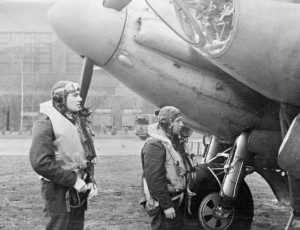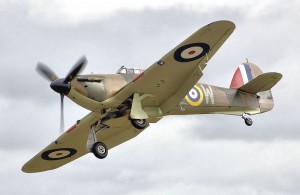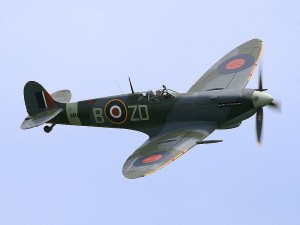
No. 2 Group. Wing Commander H I Edwards VC (left) and his navigator pre-flight their aircraft. /Wikipedia
This week, I had the opportunity to watch a very well done documentary on the Battle of Britain. Hosted by Ewan McGregor and his brother Colin, they told of how they grew up in England studying about the fighter pilots who flew in the Battle of Britain. They reported building model airplanes in their youth and studied the facts of the war in the summer of 1940. The story they told went beyond history and into the lives of the Spitfire and Hurricane pilots who flew against the Germans during that time.
The stories of the old British pilots were fascinating. The elderly gentleman of today were mere boys of 17, 18, maybe 20 years of age during the war. What was more fascinating about these young men was the amount of flight training they had before entering the war. Their training before the war was very minimal and some of them went to war with no more than 30 hours experience in their combat aircraft.
Colin McGregor, two years older than his brother, Ewan, is a former Royal Air Force officer and accomplished Tornado pilot. He had the opportunity to fly three flights in three of the different airplanes a pilot would have flown leading up to the Battle of Britain.
His first aircraft flight was in a Stampe trainer. Today an elderly biplane, even when it was new, it was capable of only a fraction of the speed of the Tornado McGregor flew for the RAF. McGregor’s ability at handling the old biplane was impressive, especially if it was the first time he had ever flown one. He deftly handled the rudders and flew the landing as if he were a much more experienced pilot with a great deal of tailwheel experience.
The boys from the late 30s and 1940 would have trained for only a short time in the Stampe. It was rudimentary and basic skills were all they were to get out of flying the Stampe. England was, after all, in a grave hurry to produce new pilots and they did not have time to play with old, slow, biplanes.
After the minimal time in basic flight training flying the biplanes, the novitiates moved on to the Harvard. It was in the Harvard, the equivalent of America’s T-6 Texan (or SNJ in the Navy), that the fledgling pilots learned how to fly heavier airplanes. They also learned the fundamental skills of aerial combat in the airplane.
After gaining enough familiarity with the Harvard, the pilots moved on to the airplanes they would fly against the Germans in the skies over Britain. With very little flying experience, these young men of the Royal Air Force found themselves flying 400 mile-per-hour Spitfires, Hurricanes, and other aircraft against the Germans.
Once assigned to their combat units, the British pilots discovered the Germans horribly outnumbered them. Often, they would launch against the incoming Germans with only 10 or 12 airplanes against more than a hundred enemy aircraft. In a speech he delivered on August 20, 1940, Winston Churchill said of the fighter pilots, “The gratitude of every home in our Island, in our Empire, and indeed throughout the world, except in the abodes of the guilty, goes out to the British airmen who, undaunted by odds, unwearied in their constant challenge and mortal danger, are turning the tide of the World War by their prowess and by their devotion. Never in the field of human conflict was so much owed by so many to so few.”
There is little question the men flying the Spitfires, Mosquitos, and Hurricanes were the first who started saving the world. If you sit down and think about it, that is, sincerely think about it, you come to realize the men who saved Britain were the epitome of heroes. These men were the true definition of fighter pilots.
They did what they had to do and they did so without complaint, with stoic courage, and a sense of duty. They were very much the heroes of England and, as inferred by Churchill, the world.
The McGregor brothers produced this television documentary in 2010, 70 years after the event of the battles in the skies over Britain. If you have the chance, take the time to watch the McGregor’s film, Battle of Britain.
You will thoroughly enjoy it.
-30-
©2012 J. Clark
Note: Email subscribers, please go to my blog to view vids



Pingback: 80 Years Young | joeclarksblog.com